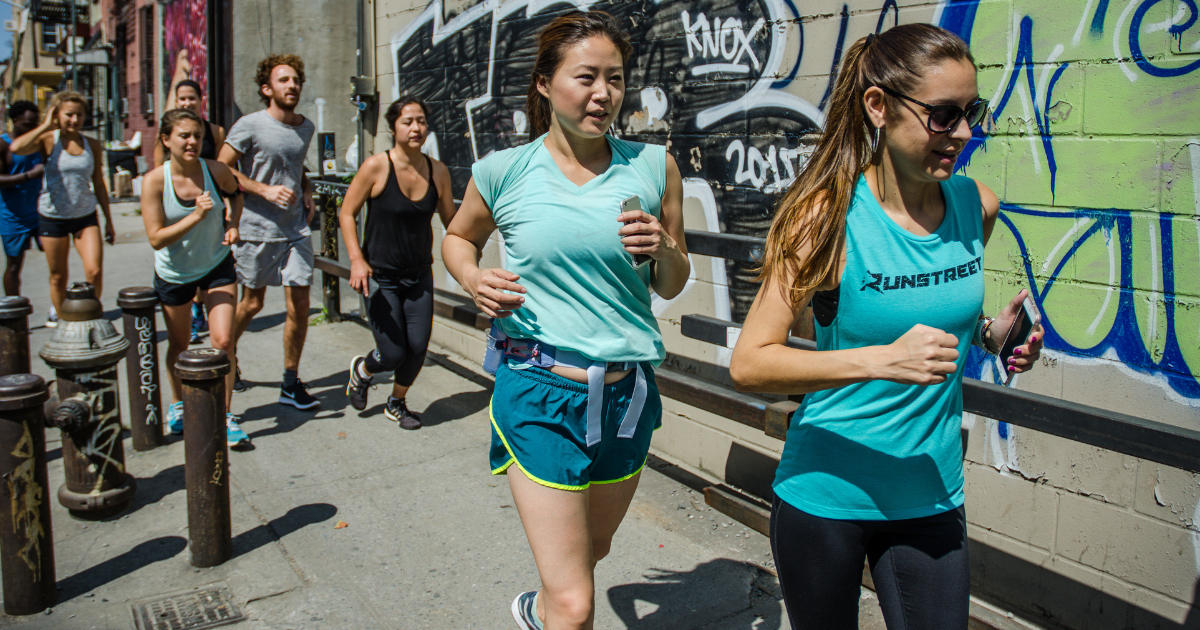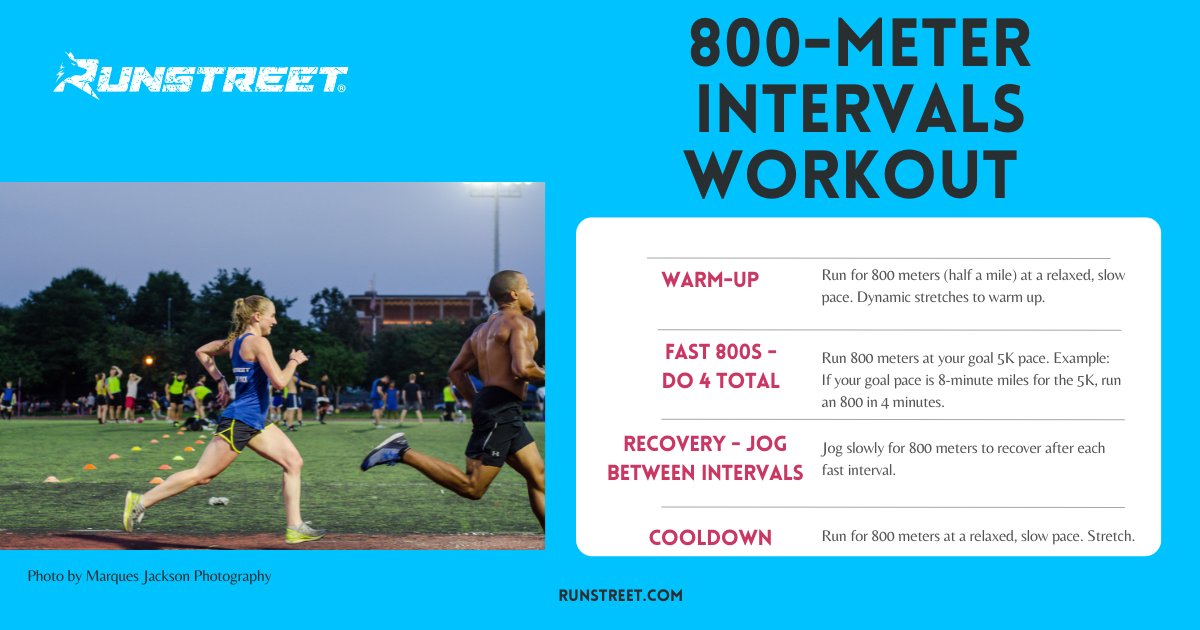5 Speed Workouts for 5K Success
Photos by Marques Jackson Photography.
By Marnie Kunz, NASM-certified trainer, USATF- RRCA-certified run coach
If you’re looking for speed workouts for 5K success, you’ve come to the right place. The 5K is the most common race distance, and the right speed workouts will help you crush your race time goal. As a running coach and longtime runner, I love helping people improve their race times. The 5K has a special place in my heart as it was my first race distance as a young cross country runner. These 5 speed workouts will help you improve your 5K time and become a faster, stronger runner.
Related: 25 Running Tips for Beginners
5K Training
There are thousands of 5K races every year, and for good reason — the 5K (or 3.1 miles) race distance is challenging yet attainable for most people. If you are training for your first 5K and need to build up your endurance, I highly recommend following a training plan. This will help your body build endurance gradually and minimize your risk of injury.
Before you begin speed training for your 5K, it’s important to build up your fitness base. If you are a beginner or easing back into running, I recommend running regularly for at least 6 to 8 weeks before beginning a speed training program. If you need a beginning 5K training plan to build your fitness base and transition from walking to running, check out the Runstreet Lone Wolf 5K Training Plan.
Building a fitness base will help prepare your body for more intense training. For your base runs, you want to run at a relaxed pace, one at which you can keep up a conversation. At the base building stage of your training, don’t worry about going fast. Many beginning runners I coach think they need to push to go fast every run, but this is a recipe for burnout and injury. For more tips on how to build your endurance base, check out my article on base runs.
Related: 10 Most Fun Virtual 5K Races
Speed Workouts for 5K Racing
Once you have built your endurance base and have been running regularly for at least 6 weeks, it’s time to step up the program. These speed workouts for 5K racing will help you get faster and lower your 5K race time. When doing speed workouts, keep in mind the easy-hard principle of training, and always schedule a base run day the day before your speed workout and an active recovery or rest day following your speed workout.
As with most fitness training, consistency is key for seeing improvements. Sometimes coaching clients expect immediate results but the truth is it takes at least 4 to 6 weeks to start seeing improvements in speed. So keep up the speed workouts at least once or twice a week, and know the results are coming.
5K Intervals Workout
Intervals are periods of faster, intense running interspersed with recovery segments. Interval workouts help improve your running speed and efficiency and will make you a stronger, faster runner for your 5K race. These speed workouts train your body to go faster, sometimes even faster than your goal race pace, in small segments. The shorter speed bursts make interval training more manageable and build up your speed so that you’re ready to crush your 5K on race day.
These 5 speed workouts for 5K success progress from the beginners level to more advanced. I recommend doing the beginners level interval workouts for at least two weeks before advancing to the 400- and 800-meter intervals. Once you can maintain your pace for the 800-meter intervals, it is time for the ladder workout. The mile repeats will be your last speed workout before your 5K race.
Beginners 5K Interval Workout
Warm up by running for 5 minutes at a slow, relaxed pace. Do dynamic stretches.
Run for 1 minute at 80% effort level. This will feel like a fast pace but not your fastest speed. Your speed should be close to your 1-mile race pace for the bursts of speed.
Run for 2 minutes at a relaxed recovery pace.
Repeat to run a total of 10 fast 1-minute intervals and 20 minutes of recovery jogging.
Cool down with 5 minutes of relaxed pace running. Stretch.
When you run the fast intervals, try to keep a consistent pace for each one. Start out slowly as you will need to maintain your pace for the speed bursts. Do this beginner’s 5K interval workout for at least two weeks before advancing to the 400-meter intervals.
400-Meter Intervals Workout
Warm up by running for 800 meters or .5 of a mile at a slow, relaxed pace. Do dynamic stretches.
Run for 400 meters or .25 of a mile at 80% effort level. This will feel like a fast pace but not your fastest speed.
Jog for 400 meters at a relaxed recovery pace.
Repeat to run a total of 6 fast intervals and 6 recovery jogs.
Cool down with 5 minutes of relaxed pace running. Stretch.
800-Meter Intervals Workout
Warm up by running for 800 meters or .5 of a mile at a slow, relaxed pace. Do dynamic stretches.
Run for 800 meters or .5 of a mile at your goal 5K pace. For instance, if your goal pace is 9-minute miles, run 800 meters at a 9-minute mile pace, which is a time of 4:30 for 800 meters.
Jog for 800 meters at a relaxed recovery pace.
Repeat to run a total of 4 fast intervals and 4 recovery jogs.
Cool down with 5 minutes of relaxed pace running. Stretch.
Ladder Intervals Workout
Warm up by running for 800 meters or .5 of a mile at a slow, relaxed pace. Do dynamic stretches.
Run for 200 meters or .125 of a mile at 80% effort level.
Jog for 200 meters at a relaxed recovery pace.
Run for 400 meters or .25 of a mile at 80% effort level.
Jog for 400 meters at a relaxed recovery pace.
Run for 800 meters or .5 of a mile at 80% effort level.
Jog for 800 meters at a relaxed recovery pace.
Run for 400 meters or .25 of a mile at 80% effort level.
Jog for 400 meters at a relaxed recovery pace.
Run for 200 meters or .125 of a mile at 80% effort level.
Jog for 200 meters at a relaxed recovery pace.
Cool down with 5 minutes of relaxed pace running. Stretch.
1-Mile Repeats
Warm up by running for 800 meters or .5 of a mile at a slow, relaxed pace. Do dynamic stretches.
Run for 1600 meters or 1 mile at your goal 5K pace.
Jog for 800 meters at a relaxed recovery pace.
Repeat to run a total of 2 fast mile intervals and 2 recovery jogs.
Cool down with 800 meters of relaxed pace running. Stretch.
If you are an advanced runner, you can do one more repeat to run 3 sets of the mile repeats.
Bonus: Tempo Run
Another form of speed workout that can help you crush your next 5K race in record time is the tempo run, also called a threshold run. In contrast with intervals, for a tempo run you will maintain a challenging but steady pace for the whole speed portion of your workout. The tempo run increases your oxygen efficiency and trains your body to run fast even while fatigued, improving your overall performance.
Your tempo pace is usually similar to your 10K race pace time, at about 70 to 80 percent effort level. Your intensity will be at a comfortably hard pace, at a speed you could maintain for up to an hour (but with effort and focus).
For a beginner's tempo run, do 10 minutes of slow jogging to warm up. Then run at your tempo pace for 20 minutes, followed by a cool down of jogging for 10 minutes.
Speed Workout Training Tips
Strength Train to Get Faster
In addition to your speed training and easy runs, also do regular strength training. Adding strength training to your routine is one of the best ways to become a stronger, faster runner.
You can do bodyweight workouts or lift weights twice a week to hit your peak performance. A basic strength workout may include 3 sets of 10 reps of different exercises to improve your full-body strength, with push-ups, squats, planks, lunges, and dips.
Consistency Is Key
Stay consistent with your speed workouts for 5K success as much as possible. Add speedwork to your training schedule at least once a week (optimally twice per week) to see the best results. Even one workout a week that's interval training or a tempo run will make a big difference in your 5K race pace.
Outside of your speed sessions, the majority of your runs should be at an easy pace, one that feels natural to you. You should be able to carry on a conversation for your relaxed pace base runs.
Add Strides
If you are serious about improving your 5K race speed and have the time, I also recommend doing strides. Strides are short, fast running drills involving exaggerated striding. You can do strides after a workout or as part of your dynamic stretches when you warm up before a race or run. See my tips on how to do strides for more details.
Finding Your Pace
If you are finding it too hard to hit your goal race pace during your speed workouts, then it may be time to readjust your time goals. The speed workouts will be challenging but not impossible. So if you can’t hit the goal race pace at all even in a shorter distance interval, then it is time to make your race time goal more attainable. I recommend reassessing your goals every month to stay on track with your progress and milestones.
Taper
Finally, before race day, taper your workouts. For the 5K, this means reducing your mileage and intensity in the week before your race. This allows your body to fully recover from training and prepare to hit your peak on race day.
Follow a Training Plan
Do you have a 5K race coming up? If you need a customized training plan with speed workouts and pace suggestions just for you, check out my Customized Running Training Plans. If you try any of these speed workouts for your 5K training, let me know how it goes, and tag @Runstreet on Instagram to get cheered on.😊
Related Posts: How to Do The Base Run, Running Pace Chart for All Levels, How to Run Strides, Dynamic Stretches for Runners
Marnie Kunz is a NASM-certified personal trainer and USATF- and RRCA-certified running coach based in Brooklyn, NY. Marnie likes helping people get and stay active to enjoy a better quality of life. When she’s not doing fitness things, Marnie enjoys exploring with her dog, a mischievous rescue Akita.







